
This summer, SoftBank Corp. (TOKYO:9434) deployed pre-commercial 5G services at Japan's largest outdoor rock music event, FUJI ROCK FESTIVAL ‘19. The annual event took place from July 26-28 at Naeba Ski Resort in Niigata Prefecture. SoftBank's pre-commercial 5G service allowed festival-goers to experience a completely new form of music entertainment for the first time.
The 5G Strategy Section at SoftBank's Mobile Network Division played a key role in bringing 5G's high-speed connectivity to the outdoor venue. SoftBank News spoke to Seiya Kagawa, an engineer involved in constructing 5G networks for pre-commercial services, to learn more about SoftBank's 5G initiatives.
5G will be a foundational technology for industries, not just smartphones
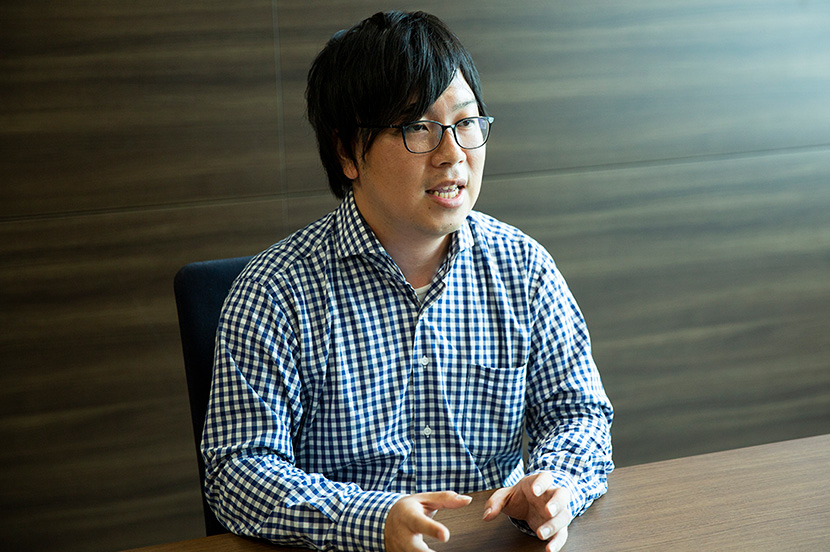
Seiya Kagawa of the 5G Strategy Section in SoftBank's Mobile Network Division spoke to SoftBank News.
What does the 5G Strategy Section do?
The 5G Strategy Section was formed this fiscal year, which started April 1, 2019, as an organization to look at deploying 5G and other new technologies ahead of the commercial launch of 5G services in 2020. When thinking about solutions for future challenges that will face businesses and society, 5G will be a foundational technology that will play a key role in infrastructure. Our section doesn't just look at technology applications—we also consider business plans and their commercialization.
Does this mean that 5G technology applications will be mainly for enterprises?
In addition to being a new standard for smartphones, 5G holds promise for self-driving, robotics, IoT and other business applications. To meet the wide-ranging needs of different industries, we need to work with our corporate sales divisions and design new solutions. That way we can show companies how 5G can be utilized to address the issues they're facing.
At the same time, it's important to promote services for consumers. In the 5G era, expectations are high for consumer services that will deliver high-definition video in real time.
That said, it's hard for consumers to imagine specific services and benefits resulting from 5G speeds, which are much faster than today's 4G services. In that sense, we thought this pre-commercial service at FUJI ROCK would provide a good opportunity to make people aware of 5G's potential.
Participants in different locations can virtually high five each other with 5G-enabled VR

Festival-goers experienced 5G-enabled VR at the SoftBank booth.
What did the 5G pre-commercial service offer?
People could experience two things.
One experience was a VR space based on the live video feeds that utilized the high speed and high capacity of 5G. Festival-goers at the SoftBank booth in FUJI ROCK's Naeba venue wore VR headsets to become avatars and enter a VR space generated by computer graphics. They could watch and listen to live on-screen footage via the 5G network to enjoy an experience similar to actually being there. Also, at a special venue in Tokyo called “TV Asahi Roppongi Hills Summer Festival SUMMER STATION,” we used a fiber optic cable to provide a similar VR experience. With our VR experiences to date, people at the same location entered the VR space as avatars and enjoyed conversations with each other, but this time participants in different locations, Naeba and Tokyo, could high five each other and communicate in the same virtual space. This made the experience really exciting for participants.
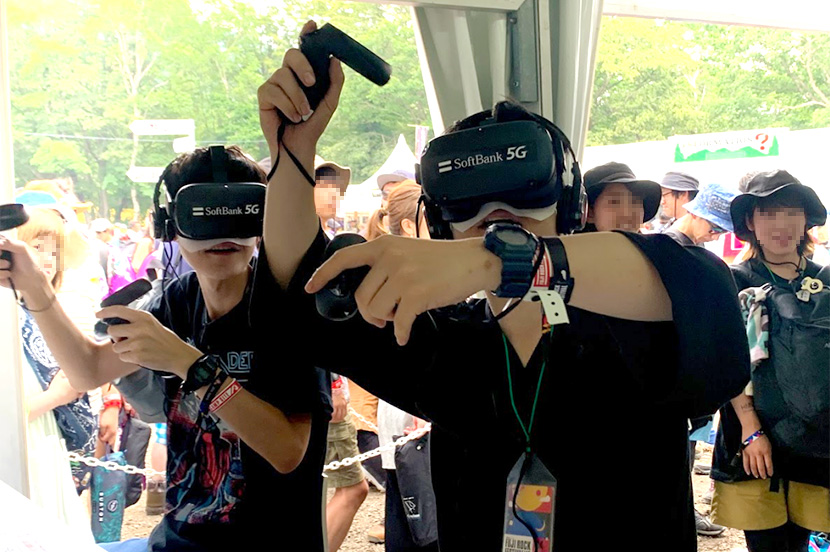
Participants use controllers to control their avatars.
The other experience was an app that used a 5G network to livestream the situation at each concert venue using eight on-location cameras. FUJI ROCK has a lot of different concert stages on its grounds. Festival-goers could use the app to check congestion before moving to the next live venue.

Eight cameras were set up on the grounds of FUJI ROCK FESTIVAL ‘19.
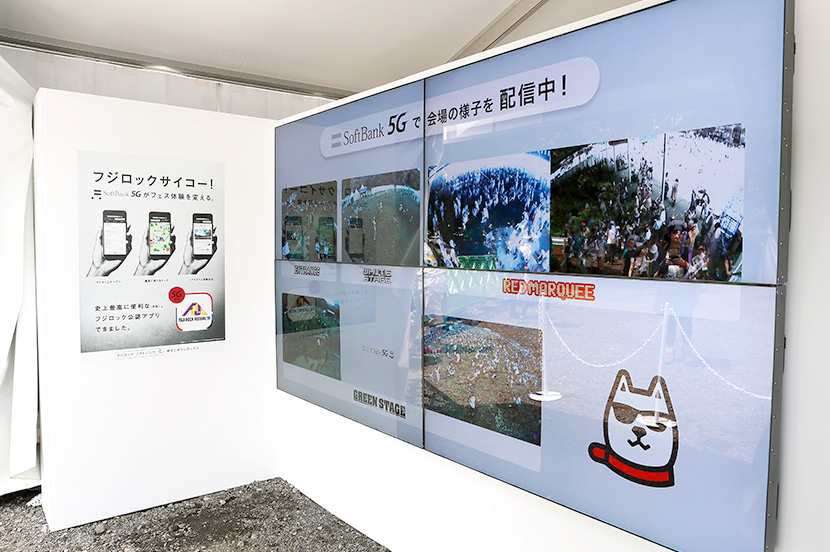
Beside the SoftBank booth, festival-goers could view live 5G video feeds to check congestion.
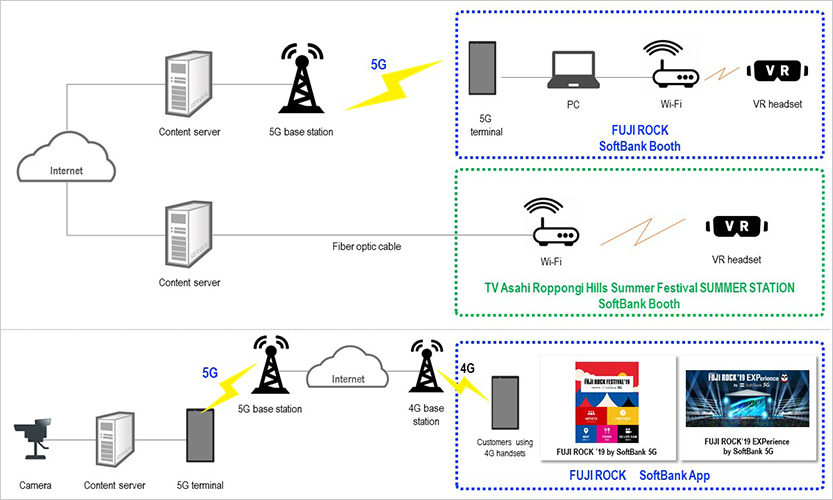
Network formation
Being Japan's first pre-commercial 5G service at a music festival, were there any big hurdles?
To conduct this 5G pre-commercial service at FUJI ROCK, first we needed a license from the Ministry of Internal Affairs and Communications to set up a radio station. We started verification work in December of 2018 and applied for a preliminary license in February 2019. We passed the test for our network formation and were licensed in this domain for the first time.
We conducted our work while keeping the lead time in mind, but since the venue was at Naeba—a well-known ski resort—we couldn't get in there for a long time due to the large snowfalls. The actual field surveys took place two months prior to the event, and our staff and engineers got there one week ahead of time to set up the network. Most of the final content adjustments took place two days before the festival opened. So it was a real race against time to provide customers with a quality experience.
For software and hardware, we continually conducted verifications in Tokyo and made on-site installations, but there are things you can't know until you actually go to the venue. We encountered various difficulties on-site; there was a power outage before the event so we didn't get the functionality we were hoping for initially, and so on. Despite those challenges, we worked together as a team to troubleshoot and were relieved when the event ended successfully.
Last year we helped FUJI ROCK with mobile network capacity measures and SoftBank supported YouTube video for the event, so it was easy to work with the organizers. With this external and internal cooperative framework in place, I'd like to make good use of the experience we gained in event countermeasures.
Tell us about the network characteristics.
Since this was a pre-commercial 5G service, we used an experimental radio station using the 3.7GHz band to construct a Non-Standalone (NSA) network with 5G equipment collocated with 4G equipment. Since we needed to build out additional 4G network coverage for the pre-commercial service within the existing 4G network coverage area, we designed the network in such a way so that there was no interference with existing 4G radio waves.
We had to design the network in such a way to ensure quality for customers. On one hand, we needed to maintain communication quality for SoftBank customers coming to FUJI ROCK, and on the other, we needed network coverage for the SoftBank booth and cameras to provide VR and app content for the 5G pre-commercial service. Since our know-how in 5G network area design is limited, it was a continual process of trial and error.

A mobile base station equipped with a 5G antenna. The taller antenna is a 4G one to boost network coverage for SoftBank customers.
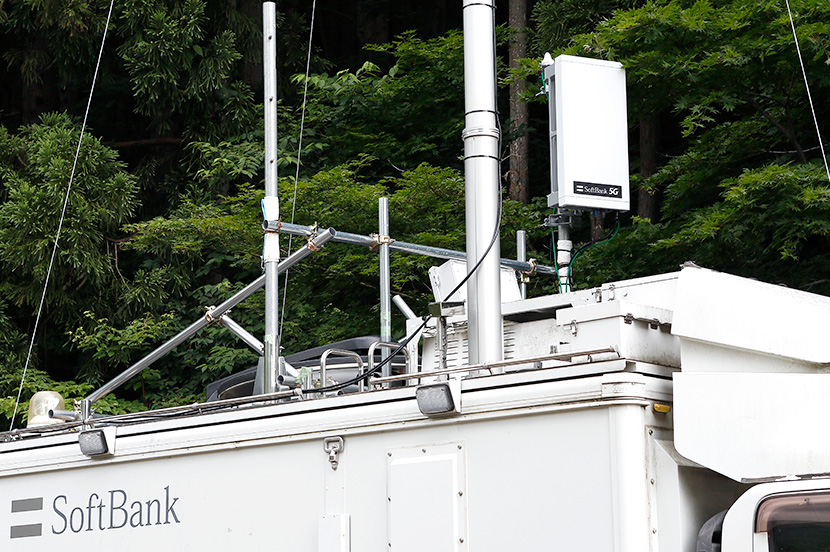
The 5G antenna, with a black sticker, is located at a lower position to transmit radio waves to the SoftBank booth and cameras at different concert venues.
Making high-speed and high-capacity communications comfortable anywhere in Japan with 5G
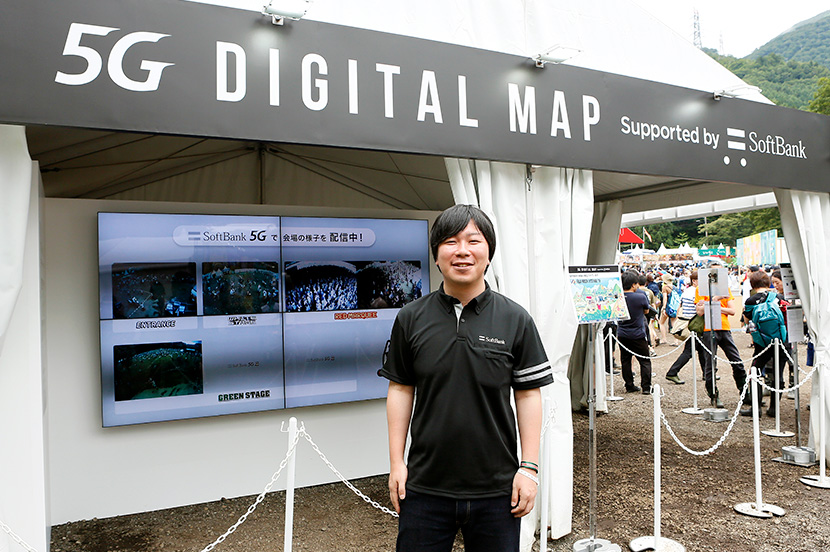
Why did you decide on FUJI ROCK as a venue to showcase pre-commercial 5G?
While it's difficult to communicate the benefits of 5G to general consumers, at SoftBank our main message to customers is that we'd like to “update their lifestyles.” So we had to ask ourselves how customers could experience the benefits of 5G, which include enjoying high-resolution images without getting stressed out about communication speeds. The answer we came up with was entertainment, including sports and music, since this is a genre that can be easily understood by all.
Thanks to its high-capacity communications, it can be said that 5G is well-suited to events with huge turnouts like sports matches and music festivals. From a pre-commercial service perspective, in my view FUJI ROCK—with its attendance of approximately 120,000 people a year—was a great venue to showcase 5G's benefits and have people experience them first-hand. Also, in March we conducted VR trials at FUKUOKA YAHUOKU! DOME that were very well received, so we could confirm that 5G is well suited to sports events. While we conducted trials that fused sports and 5G in Fukuoka, at FUJI ROCK we offered a pre-commercial 5G service that combined music with 5G. We could see once again how 5G is compatible with entertainment. We also plan to offer 5G pre-commercial services at the Team Japan matches during the International Basketball Games 2019 in August.
5G is not just about communication—there are also high expectations for 5G as industrial infrastructure. Just as our video feeds displayed congestion updates, with 5G we'll be in an optimal position to propose new solutions to enterprise customers.
Did you gain any new insights with this pre-commercial service?

A briefing was held on-site for journalists.
While 5G enables the transmission of high-definition images and audio with low latency, due to its high-frequency, radio waves tend to propagate in one direction and dampen easily. This means these radio waves don't easily reach into buildings and other shielded objects. When deploying 5G to rural areas and wide areas outdoors, there's the issue of how to construct a communication network, but on top of that there are areas with varying elevations like mountainous terrain, forested areas and locations where many are moving to. This event helped us acquire data on how environmental factors affect 5G radio waves, learn about optimal heights for base station antennas and more.
Also, in mountainous areas without fiber optic cables, with 5G networks there's no need to construct cable facilities or make new investments. It's also easier to manage on both a cost and operating basis with 5G. For periodic events in natural settings like FUJI ROCK, we can flexibly meet the needs of organizers.
While we gained a lot of good insights using technical and test data, when 5G is deployed nationwide, we'll be able to offer similar experiences regardless of location. We also discovered that 5G can open the door to new, VR-based methods of communication.
Building on this 5G pre-commercial service experience, what do you want to do next?
5G is not a technology just for speeding up communications on smartphones. 5G's high speeds and capacity, low latency and massive device connectivity will open up a wide playing field, give birth to new devices, and lay a new foundation for industries. Without a doubt, 5G will be integral to the future.
SoftBank has a long history of introducing the latest technologies to build new services. Whether it's services for consumers or solutions for enterprises, we want to tie up with leading-edge companies inside and outside Japan to resolve various issues. We want to be at the forefront of advanced technologies like 5G that will form foundational services.
(Original article posted on August. 16, 2019)
Text by Shinji Nakao (freelance writer)
Photos by Daisuke Kurihara (Roaster)
Edited by Akiji Osaki (Roaster), Mai Obata (Roaster)


